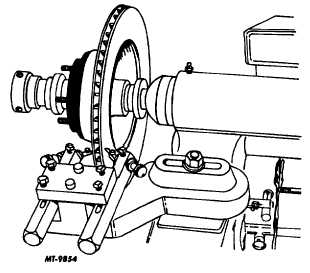|
| |
TRUCK SERVICE MANUAL
TM 5-4210-230-14&P-1
BRAKES-HYDRAULIC
Excessive variation can cause pedal vibration or
fight, front end vibrations and possible "grab" during the
braking action--a condition comparable to an out-of-round
brake drum.
To make the thickness variation or parallelism check
on the rotor at the same time the runout is being checked, use
a micrometer to check the variation in thickness of the rotor at
four equal points around the rotor (Fig. 18).
Fig. 18 Checking Rotor with Micrometer
If the thickness varies more than .0127 mm (.0005
in.) refacing of the rotor will be required; or replace it if the
rotor will not true up before minimum allowable thickness is
obtained.
REMACHINING ROTORS
The rotors can be remachined to provide a new,
smooth braking surface (Fig. 19). If the rotor will not true up
before minimum allowable thickness (see Specifications) is
obtained, it must be replaced.
Fig. 19 Correct Method of Refacing Rotor
IMPORTANT
Rotors
are
identified
by
the
minimum
allowable thickness they can be used. Any
rotor thinner than the minimum dimension
must not be used.
Removal of too much metal would cause overheating
and, more important, a thin rotor could permit the seals in the
cylinder to "uncover".
To uncover a seal in the cylinder would result in loss
of hydraulic brake fluid. An uncovered seal would not be
apparent at first, but as the pads wear, more travel of the
cylinder would be required; and since the rotor would be too
thin, the seals could leak.
ROTOR REMACHINING SPECIFICATIONS
Brake Group
Code No
Rotor Original Thickness (New)
Minimum Allowable Remachining
Thickness
Minimum Use- able Thickness
in.
mm .
in
mm.
in
mm
04135
1.240
31.50
1.195
30.353
1.180
29.97
04138
1.180
29.97
1.135
28.429
1.120
28.45
04139
1.180
29.97
1.135
28.429
1.120
28.45
04140
1.180
29.97
1.135
28.429
1.120
28.45
CTS-2779 Page 8
PRINTED IN UNITED STATES OF AMERICA
|


